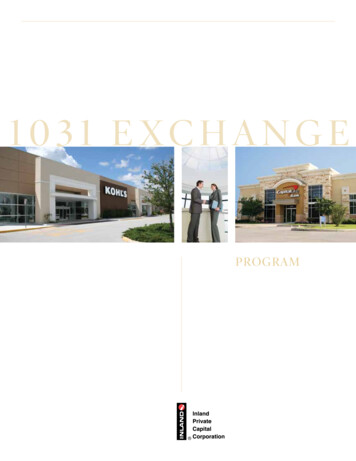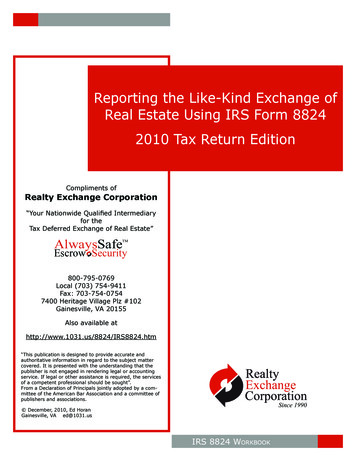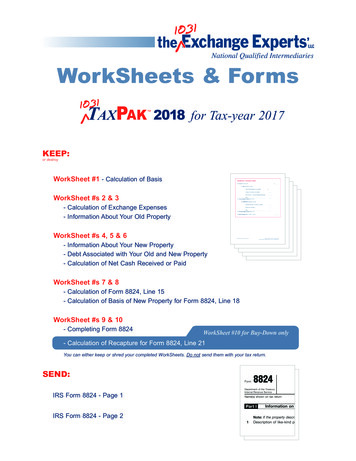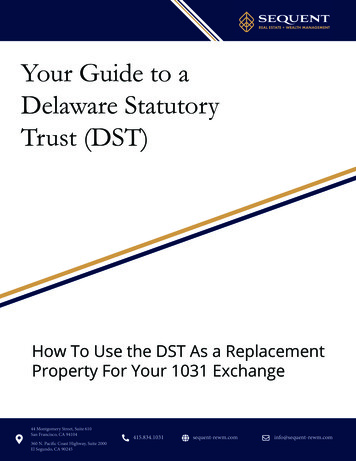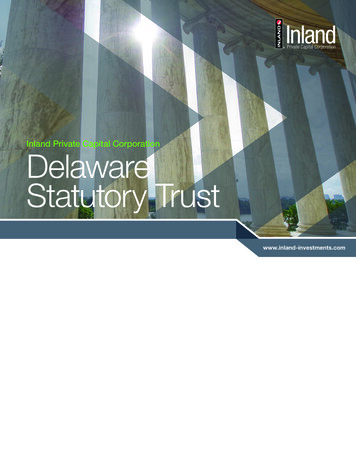
Transcription
CONTENTSPurpose of this Handbook . 1Introduction to §1031 Exchanges and Asset Preservation, Inc. (API) . 1Opening a §1031 Exchange with Asset Preservation, Inc. . 2Exchange Requirements . 2Closing an Exchange – Sale of Relinquished Property . 3Closing an Exchange – Purchase of Replacement Property . 4Answers to Frequently Asked Questions. 5Delayed Exchange Overview. 7Parking Arrangement Overview (Improvement and Reverse Exchanges) . 8Tax Deferred Exchange Terminology. 9New Exchange Information Sheet – Sale (Phase I) . 10New Exchange Information Sheet – Purchase (Phase II). 11Sample Settlement Statements:Sale of Relinquished Property . 12Purchase of Replacement Property . 13Sale of Relinquished Property (Partial Exchange with Cash Taken). 14Sale of Relinquished Property with Multiple Sellers (One Exchanges, the Other Sells) . 15Sale of Relinquished Property-Split Transaction (Part Investment, Part Primary Residence). 16Purchase of Replacement Property (With Non-Exchanging Co-Owner) . 17Purchase of Replacement Property (Deposit Reimbursement to Exchanger) . 18Exchanger Checklist . 19How to Contact Us . 20
THE CLOSER’S HANDBOOKHOW TO CLOSE §1031 TAX DEFERRED EXCHANGESNOTICESThis handbook is only intended to provide a broad overview regarding many aspects of IRC Section 1031 taxdeferred exchanges. It is not designed to address all tax deferred exchange issues, nor the specific circumstancesthat may be faced by an investor or closer. Asset Preservation, Inc. does not provide tax or legal advice. Allinvestors are urged to seek independent legal/tax guidance on each transaction as circumstances often changeand can affect the validity of an IRC §1031 exchange.FOR MORE INFORMATIONContact Asset Preservation’s National Headquarters, Eastern Regional Office, or any local office for moreinformation regarding:yyyyyInvestor WorkshopsTax Deferred Exchange Training for Closing Attorneys/Closers/Escrow OfficersAccredited continuing education (three and four hour) seminars for real estate agents and brokers,attorneys and accountantsIn-office seminars on advanced exchange topicsCustomized marketing materialsA National IRC §1031 “Qualified Intermediary”NATIONAL HEADQUARTERS4160 Douglas Boulevard Granite Bay, CA 95746Toll-Free: 800-282-1031Fax: 916-791-6003EASTERN REGIONAL OFFICE4062 Grumman Boulevard, Bldg. 81A Calverton, NY 11933Toll-Free: 866-394-1031Fax: 631-369-4094Member:www.apiexchange.com 2005 Asset Preservation, Inc.
INTRODUCTIONPurpose of this HandbookThe primary objective of this handbook is to provide an overview of the closing process for closing officers,closing attorneys and escrow officers. This handbook provides an overview of key §1031 exchange terms andcontains examples of settlement statements prepared to reflect various potential §1031 exchange scenarios. Inaddition, this handbook contains brief explanations of the different exchange variations, rules for tax deferraland suggested language to include in the Purchase and Sale Contract. (Note: This handbook is only provided forguidance and the examples may not apply to every situation or be appropriate for local closing practices. Pleaseconsult with your legal and tax advisors regarding your specific situation.)Background - IRC Section 1031 Tax Deferred ExchangesSince 1921, savvy investors and real estate professionals have been taking advantage of a powerful tax strategycreated by IRC Section 1031 – the tax deferred exchange. You and your clients can accumulate wealth andpreserve real estate assets by learning how to defer capital gain taxes when disposing of virtually any property“held for investment.” Thanks to IRC Section 1031, a properly structured exchange allows an investor to sell aproperty, reinvest the proceeds in a new property and defer all capital gain taxes. IRC Section 1031(a)(1) states:“No gain or loss shall be recognized on the exchange of property held for productive use ina trade or business or for investment, if such property is exchanged solely for property oflike-kind which is to be held for productive use in a trade or business or for investment.”Background – Asset Preservation, Inc.Asset Preservation, Inc. (API) was founded in 1990 with the unique focus of becoming an industry leader in thesecurity of its clients’ funds and property. In 1993, API was acquired by Stewart Title Company in Houston,Texas. Stewart Title’s parent company, Stewart Information Services Corporation (SISCO), is listed on the NewYork Stock Exchange (STC) and has roots in the title insurance industry that span over a century.API is one of the most respected national “Qualified Intermediaries” in the United States. At API, we arecommitted to providing investors and real estate professionals with the highest level of experience, expertise andsecurity of funds in the industry – what we call the API Advantage. The API Advantage gives investors secureaccess to the full power of exchanges, turning goals for financial growth and security into a very rewardingreality. API's team consists of highly specialized experts in the §1031 tax deferred exchange field. We havefacilitated over 100,000 exchanges of all types and dollar amounts. Our documents and system have beenanalyzed by hundreds of attorneys and by the Internal Revenue Service. Our services are designed to provide thehighest security for funds held and to maintain the integrity of every exchange.API’s role as a “Qualified Intermediary” is very specific. Our sole purpose is to guide an investor through a§1031 exchange. We inform an investor of the exchange requirements, produce the necessary exchangedocuments and manage their funds. In no way does API replace competent tax or legal advisors.Mission: To excel as the premier §1031 “Qualified Intermediary” company nationally by delivering superb service,the highest levels of security for proceeds and value-added solutions from the industry’s foremost experts.www.apiexchange.com(800) 282-10311
OPENING A §1031 EXCHANGE WITH ASSET PRESERVATION, INC.1. Always recommend that the investor discuss a §1031 tax deferred exchange with their tax or legal advisors.2. Call API’s National Headquarters toll-free 800-282-1031 or the Eastern Regional Office toll-free 866-3941031 for a free consultation at any time and definitely before closing on the relinquished property. You caneither open the exchange by A) calling API toll-free, B) order online at www.apiexchange.com, click on“Open New §1031 Exchange” or C) by completing the New Exchange Information Sheet – Sale (Phase I) inthe Appendix. The following information is needed to begin preparing the exchange documents:I.II.III.The name, address, email and telephone number of the Exchanger;The closing officer, processor or closing attorney’s name, address, email, telephone and filenumber;The real estate agent’s name, address, email, telephone and fax numbers.3. Ensure that the Purchase and Sale Agreement is “assignable” and that all parties to the contract are madeaware of such assignment in writing. It is common to show the seller as “John Doe and/or assignee.”4. Include verbiage establishing the intent to perform a §1031 tax deferred exchange in the Purchase and SaleAgreement. The §1031 exchange language should establish three things:A) Intent to perform a §1031 tax deferred exchange;B) Release the Buyer from any liabilities or costs resulting in the Exchange;C) Notify the buyer in writing of the assignment.Exchange Language - Sale of Relinquished Property:“Buyer is aware that Seller is to perform an IRC §1031 tax deferred exchange. Seller requests Buyer’s cooperation in suchan exchange, and agrees to hold Buyer harmless from any and all claims, liabilities, costs, or delays in time resulting fromsuch an exchange. Buyer agrees to an assignment of this contract to Asset Preservation, Inc. by the Seller.”EXCHANGE REQUIREMENTSAll exchange documents need to be delivered to the closing officer and signed by the Exchanger prior to closing.These documents convert the transaction from a sale to an exchange with the Qualified Intermediary as theseller and authorize the closing officer to forward the proceeds from the sale to the Qualified Intermediary.Both the “relinquished” and "replacement" properties must be held for use in a trade or business or forinvestment. The IRS uses the term "like-kind" to describe the type of properties that qualify. Any property heldfor use in a trade or business or for investment can be exchanged for any other “like-kind” property held for usein a trade or business or for investment.The IRS requires an investor to identify the replacement property(s) within 45 days from closing on the sale of arelinquished property. The 45-Day Identification Period begins on the closing date, and the replacementproperty(s) must be properly identified in a letter signed by the Exchanger and received by the QualifiedIntermediary. Close on the replacement property by the earliest of either: 180 calendar days after closing on thesale of the relinquished property or the due date for filing the tax return for the year in which the relinquishedproperty was sold, whichever is earlier (unless an extension has been filed).To defer all capital gain taxes, an Exchanger must buy a property or properties of equal or greater value (net ofclosing costs), and reinvest all net proceeds from the sale of the relinquished property. Any funds notreinvested, or any reduction in debt liabilities not made up for with additional cash from the Exchanger, isconsidered “boot” and is taxable.www.apiexchange.com(800) 282-10312
CLOSING AN EXCHANGE –SALE OF RELINQUISHED PROPERTYStep #1: Contact Asset Preservation, Inc.Either A) call API’s National Headquarters toll-free 800-282-1031 or the Eastern Regional Office toll-free 866394-1031, B) order online at www.apiexchange.com, click on “Open New §1031 Exchange” or C) complete theNew Exchange Information Sheet – Sale (Phase I). API will send exchange documents and instructions to you.Step #2: Exchange DocumentsObtain signatures on the following exchange documents:A) Closing InstructionsB) Exchange Agreement including Schedule 1C) Assignment of Relinquished Property Sale ContractD) Notice of Assignment of Rights Under Relinquished Property Sale Agreement (All Parties to Sign)E) New Account Form (SSN or TIN required)Step #3: Closing Instructions and/or Settlement StatementsWith the execution of the documents referenced in Item #2, API becomes your assigned Seller, therefore:A) Please identify the Seller in your instructions and/or statements as:Asset Preservation, Inc., as Qualified Intermediary for (Exchanger’s name here).B) Obtain API’s signature on your closing instructions and/or settlement statements. Fax yourinstructions and/or settlement statements to your Exchange Counselor at either the NationalHeadquarters or our Eastern Regional Office.C) Obtain the Exchanger’s approval of all instructions and/or statements PRIOR to closing yourtransaction. Furthermore, please retain a copy of the instructions as your authorization to acceptAPI as the Seller in place of Exchanger in the closing.D) Reflect API’s Exchange Fee on the closing statement as Paid Outside of Closing (“POC”). (We willdeduct our fee from the exchange proceeds upon our receipt.)Step #4: DeedingYou shall transfer the property directly from the Exchanger to the Buyer. (In the event you find any discrepanciesbetween how the title is currently vested and API’s documents, please contact us immediately.)Step #5: Exchange Proceeds Distribution/Wiring InstructionsImmediately upon closing and prior to wiring funds you need to fax the following items to your ExchangeCounselor at either the National Headquarters or Eastern Regional Office:Final Settlement Statement and/or our Closing Information Sheet that will be included in ourdocumentation package and should be completed as to the closing date and amount of wire transfer.New Account Form – Executed and completed with the Exchanger’s SSN or TIN.All wire transfers must reference API’s order number and the Exchanger’s name. (Note: Please remit proceeds bywire transfer. Do not issue checks.)Step #6: Form 1099SA) The Seller is to be identified as the Exchanger.B) Check Box #4 on the 1099S Form to reflect that other property will be received as consideration.Step #7: Forwarding Documents to Asset Preservation, Inc.Upon closing, return all executed documents referenced in Item #2, along with a copy of the final closinginstructions and/or settlement statement, and API’s Closing Information Sheet to API.www.apiexchange.com(800) 282-10313
CLOSING AN EXCHANGE – PURCHASE OF REPLACEMENT PROPERTYStep #1: Contact Asset Preservation, Inc.Either A) call API’s National Headquarters toll-free 800-282-1031 or the Eastern Regional Office toll-free 866394-1031, B) order online at www.apiexchange.com, click on “Open New §1031 Exchange” or C) complete theNew Exchange Information Sheet – Sale (Phase II). API will forward all exchange documents and step-by-stepinstructions to you.Step #2: Exchange DocumentsObtain signatures on the following exchange documents:A) Closing InstructionsB) Assignment of Replacement Property Purchase ContractC) Notice of Assignment of Rights Under Replacement Property Sale Agreement (All Parties to Sign)D) Request for Funds FormStep #3: Closing Instructions and/or Settlement StatementsWith the execution of the documents referenced in Item #2, API has become your assigned Buyer, therefore:A) Please identify the Buyer in your instructions and/or statements as:Asset Preservation, Inc., as Qualified Intermediary for (Exchanger’s name here).B) Obtain API’s signature on your closing instructions and/or settlement statements. Fax yourinstructions and/or settlement statements to your Exchange Counselor at either the NationalHeadquarters or our Eastern Regional OfficeC) Obtain the Exchanger’s approval of all instructions and/or statements PRIOR to closing yourtransaction. Furthermore, please retain a copy of the instructions as your authorization to acceptAPI as the Seller in place of Exchanger in the closing.Step #4: DeedingYou shall transfer the property directly from the Seller to the Exchanger. (In the event you find any discrepanciesbetween how the title is currently vested and API’s documents, please contact us immediately.)Step #5: Request Exchange Proceeds/Forward Wire InstructionsFax the following items to your Exchange Counselor at either the National Headquarters or Eastern RegionalOffice:A) Request for Funds with your wire instructions includedB) Closing InstructionsC) Assignment of Replacement Property Purchase ContractD) Notice of Assignment of Rights Under Replacement Property Sale Agreement(Note: To assure the receipt of the wired funds in sufficient time for the closing, you should fax the completedRequest for Funds the day before you want the funds to be wired. If API receives a Request for Funds after 12:00pm (Pacific Time)/ 3:00 (Eastern Time), the wire will be processed the next business day. Fax systems canmalfunction, therefore, please call your Exchange Counselor prior to the closing date to confirm that API hasreceived the Request for Funds and that the form is in proper order to wire the exchange funds.)Step #6: Forwarding Documents to Asset Preservation, Inc.Upon closing, return all executed documents referenced in Item #2, along with a copy of the final closinginstructions and/or settlement statement to API.www.apiexchange.com(800) 282-10314
ANSWERS TO FREQUENTLY ASKED QUESTIONSQ.What if the Exchanger wants to take some cash at the close of the relinquished (sale) property?A.The Exchanger may take cash at closing. The cash received by the Exchanger may be taxable. The settlementstatement should reflect a line item as distributing this cash amount to the Exchanger (do not use terms like“boot” or “taxable” as this is something to be determined by the Exchanger’s tax or legal advisor). Theremaining Seller’s proceeds would be remitted to API as the exchange proceeds.Q.How do I prepare the Seller’s Settlement Statement when the property being sold is used as a primaryresidence and also investment property (owner-occupied multi-family, farm, B & B)?A.The most commonly used format for this type of a settlement statement is to have the Exchanger allocate apercentage of the property towards the primary residence with the balance allocated towards the investment.This format would allow you to prepare one statement instead of two. Therefore, when identifying theSeller’s name on your statement, it would read “John Seller and Mary Seller as to a % and API asQualified Intermediary for John Seller and Mary Seller as to a %.” It is important to have theExchanger (upon direction from their legal counsel or tax advisor) inform you and API as to what theallocations will be between the primary residence and the investment property.Q.I have received your exchange documents, but the closing has been delayed for a month. Can I still useyour documents?A.Yes, provided there has been no change in the Seller and Buyer’s names and the property information isaccurate. We would recommend checking with us if the documents are more than two months old.Q.Can my seller exchange a house used only as a primary residence?A.No. Section 1031 applies to property held for business, trade or investment. That would specifically excludethe seller’s residence or property acquired for resale.Q.Are API’s wiring instructions included with the exchange documents?A.Yes, API’s wiring instructions are included in our Closing Instruction Letter. In order to properly credit thewire upon receipt, it’s imperative that API’s order number and the Exchanger’s name be included in thereference. Furthermore, the Exchanger’s tax identification number and signature are required to open thisaccount so it’s necessary for you to fax us the signed and completed New Account Form before funds arewired. We also request that you provide us with API’s Closing Information Sheet and/or the final settlementstatement.www.apiexchange.com(800) 282-10315
Q.What if the Exchanger is taking title to the replacement property in a name that is different than yourexchange documents?A.The tax entity that sold the relinquished property is the tax entity that must acquire the replacement property.Therefore, we will prepare our documents for the purchase of the replacement property using the same namethat was used on the relinquished property. If the names are different, please contact us immediately toreview the situation.Q.What do I do if I have money left over from the purchase of the replacement property?A.There are several options for handling excess exchange proceeds:1) If the Exchanger remitted the earnest money deposit from their personal funds, that amount can berefunded from the overage. You would identify the Exchanger’s deposit as a line item, and then show aline item reimbursing the Exchanger for the deposit.2) A principal reduction on the new loan can be made in the amount of the overage.3) Contact API to see if the Exchanger is going to acquire more property or if the funds can be remitted to theExchanger.Q.What’s the best way to contact API with an emergency question or closing?A.Call API right away toll-free at either our National Headquarters at 800-282-1031 or our Eastern RegionalOffice at 866-394-1031. Our National Headquarters’ hours are 7:00 a.m. – 5:00 p.m. (Pacific Time) andour Eastern Regional Office hours are 8:00 a.m. to 5:00 p.m. (Eastern Time). If it is outside of our regularbusiness hours, we recommend you delay the closing in order to avoid disqualifying the exchange. In mostcases, API can provide you with documents within one hour, if necessary. Call API and press “0” for thereceptionist and ask for the first available Exchange Counselor.Q.What information does API have available to closers or investors online?A.API’s website, www.apiexchange.com, contains valuable information, resource links and is a comprehensivesource of information on tax deferred exchanges. Features include:xxxxxxxOnline Exchange InquiryExchanger’s ChecklistCapital Gain Tax Calculator45/180 Day CalculatorSign-up for Newsletter via E-MailTax Code and Legal Reference LinksAPI’s Links: Add a link to your websiteReal Estate Agent Resources: Click on PDF versions (saved in Adobe Acrobat Reader) of API’s “Power ofExchange” handouts that can be customized online and printed. This feature will be updated regularly andallows real estate professionals and closers to access the latest §1031 exchange topics.www.apiexchange.com(800) 282-10316
OVERVIEW OF EXCHANGE VARIATIONSDELAYED EXCHANGE:A delayed exchange is the most common exchange format, providing investors the flexibility of up to amaximum of 180 calendar days to purchase a replacement property. The use of a Qualified Intermediary isrequired to complete a valid delayed exchange. The Qualified Intermediary prepares the necessary exchangedocuments to assist the Exchanger with meeting the detailed requirements of the Code.Prior to closing the sale of the relinquished property, the Exchanger enters into the Exchange Agreement withAPI. Pursuant to the Exchange Agreement, an Assignment is executed prior to closing, and API assumes theExchanger's interest in the Purchase and Sale agreement. API instructs the closing officer or closing attorney todirectly deed the property from the Exchanger to the buyer. Proceeds are transferred directly to API, therebyprotecting the Exchanger from actual or constructive receipt of funds. The Exchanger must properly identifypotential replacement properties within 45 calendar days of the closing on the relinquished property. The threerules of identification are:Three Property Rule: An Exchanger may identify a maximum of three (3) replacement properties,without regard to the fair market value of the properties.Two Hundred Percent Rule: The Exchanger may identify any number of properties as long as theaggregate fair market value does not exceed 200% of the fair market value of the relinquished property.Ninety-Five Percent Exception: The Exchanger may identify any number of properties without regard tothe combined fair market value, as long as the properties acquired amount to at least 95% of the fairmarket value of all identified properties.The Exchanger has a total of 180 calendar days from closing of the relinquished property, or their tax filing date,whichever is earlier, to acquire "like-kind" replacement properties. Prior to closing on the replacement property,the Exchanger assigns the Purchase and Sale Agreement to API. After the Assignment is executed, the exchangeis completed when API purchases the replacement property with the exchange proceeds and transfers it back tothe Exchanger by a direct deed from the seller.www.apiexchange.com(800) 282-10317
“PARKING ARRANGEMENTS” (IMPROVEMENT/REVERSE EXCHANGES)Revenue Procedure 2000-37 describes “reverse” and “improvement exchanges” as “parking arrangements”because either the ownership of the relinquished property or the replacement property is “parked” with anExchange Accommodation Titleholder (“EAT”). To “park” the ownership actually means that a deed isrecorded to transfer the ownership to the EAT so that the Exchanger owns one property and the EAT owns theother property.THE IMPROVEMENT EXCHANGEAn Improvement (build-to-suit or construction) exchange allows an investor to use exchange proceeds to either:A) Make improvements to an existing property;B) Build a new replacement property.This variation is extremely popular because it provides the opportunity to purchase properties needingrenovation or to acquire bare land and build to an Exchanger’s specifications. API makes improvements to thereplacement property during the exchange period and transfers the improved property back to the Exchanger bythe 180th day.THE REVERSE EXCHANGEA reverse exchange is the purchase of the replacement property prior to closing on the relinquished property. AnExchanger may need to consider a reverse exchange in a seller's market, where properties are selling quickly andinventory is scarce. It is especially crucial that the Qualified Intermediary has in-depth knowledge of the stepsand precautions necessary in these complex transactions. Working with an investor's tax advisors and attorneys,API draws upon substantial experience with reverse exchanges to help lead the investor safely through aminefield of potential hazards.Reverse Exchange - Parking the Replacement Property: The EAT acquires title to the replacementproperty with funds the Exchanger causes to be loaned to the EAT. Within 180 days the Exchanger sellsthe relinquished property through the “delayed exchange” format and the EAT transfers the replacementproperty to the Exchanger.Reverse Exchange - Parking the Relinquished Property: The Exchanger conveys the relinquishedproperty to the EAT and then the Exchanger acquires the replacement property under a “simultaneousexchange” format. During the 180 days, the EAT remains on title to the relinquished property until it issold to a purchaser.Combined Reverse and Improvement Exchange: The EAT acquires the replacement property and makesimprovements to this property. The improved property is later exchanged for the relinquished propertywithin 180 days to complete the exchange.www.apiexchange.com(800) 282-10318
Estimated Close DateSeller / Exchanger InformationAs they areshown on ipPhone 2 / OtherFaxEmailCloser / Escrow Officer InformationNameCompanyAddressCityPhoneFaxEmailFile No.Property InformationAddress orDescription:CityCountyIs the Property:Single/Multiple Family ResidenceCommercialLandApt. Bldg.OtherReal Estate AgentNameCompanyPhoneBuyer(s)As they will beshown on titleTransaction DetailsSale Price YesIs there Seller financing?NoEstimated Mortgage Payoff If yes, amount? AdditionalInformationPlease send this form to Asset Preservation, Inc. by either:Email1)2)FaxGo to FILE in the menu bar, select SEND MAILAddress your email to: info@apiexchange.comSubject line: NEW ORDER. Please include yourcontact information1)2)Complete and Print FormFax to API - Attn: NEW ORDERPlease include your contact informationASSET PRESERVATION, INC.9National Headquarters800-282-1031 916-791-5991 Fax: 916-791-6003Eastern Regional Office866-394-1031 631-369-3617 Fax: 631-369-4094apiexchange.cominfo@apiexchange.com
New Exchange Information Sheet – PURCHASE (Phase II)Estimated Close DateBuyer / Exchanger InformationAs they will beshown on titleMailing AddressCityPhoneStateZipStateZipStateZipPhone 2 / OtherFaxEmailCloser / Escrow Officer InformationNameCompanyAddressCityPhoneFaxEmailFile No.Property InformationAddress orDescription:CityCountyIs the Property:Single/Multiple Family ResidenceCommercialLandApt. Bldg.OtherReal Estate AgentNameCompanyPhoneSeller(s)As they areshown on titleTransaction DetailsPurchase Price Is a Deposit Needed?YesIf yes, amount?No AdditionalInformationPlease send this form to Asset Preservation, Inc. by either:Email1)2)FaxGo to FILE in the menu bar, select SEND MAILAddress your email to: info@apiexchange.comSubject line: NEW ORDER. Please include yourcontact information1)2)Complete and Print FormFax to API - Attn: NEW ORDERPlease include your contact informationASSET PRESERVATION, INC.National Headquarters800-282-1031 916-791-5991 Fax: 916-791-6003Eastern Regional Office866-394-1031 631-369-3617 Fax: 631-369-4094apiexchange.cominfo@apiexchange.com10
TAX DEFERRED EXCHANGE TERMINOLOGYTo some closers, the terminology often used to describe different aspects of a tax deferred exchange can beconfusing. For example, doesn’t something with two ‘downlegs’ and three ‘uplegs’ sound a lot more like alopsided creature than an exchange transaction? Reflected below are brief descriptions of commonly usedexchange terminology:ACTUAL RECEIPT: Physical possession of proceeds.BOOT: “Non like-kind” property received; “Boot” is taxable to the extent there is a capital gain.CASH BOOT: Any proceeds actually or constructively received by the Exchanger.CONSTRUCTIVE RECEIPT: Although an investor does not have actual possession of the proceeds, they arelegally entitled to the proceeds in some manner, such as having the money held by an entity considered as theiragent or by someone having a fiduciary relationship with them. This creates a taxable event. The investor maybe deemed to have “constructive receipt” of funds if proceeds are merely deposited in a separate escrow account,without
394-1031, B) order online at www.apiexchange.com, click on "Open New §1031 Exchange" or C) complete the New Exchange Information Sheet - Sale (Phase I). API will send exchange documents and instructions to you. Step #2: Exchange Documents Obtain signatures on the following exchange documents: A) Closing Instructions



